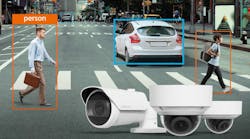It's inevitable that cloud will eventually become the default storage method for video surveillance in the professional security industry. What’s more difficult to judge is when this change will take place.
Accelerating demand for cloud solutions in the professional security market stems from their popularity in other industries, and the growing need for remote access to security systems due to COVID-19. To put it simply, cloud-based security solutions are becoming more popular due to their convenience and flexibility compared to traditional systems.
As previous barriers to the adoption of cloud such as cost, bandwidth and cybersecurity issues are broken down, it's to be expected that cloud security solutions will become widely adopted. However, this won’t happen instantaneously; it will take time to change ingrained industry habits and for familiarity with cloud systems to grow.
The Rising Popularity of Cloud
Cloud has been firmly adopted by consumers, who are now daily users of numerous cloud-based platforms including Spotify, Netflix and Google Drive. In fact, cloud solutions are so sought-after that Gartner predicts end-users’ spend on public cloud services will rise 18.4% in 2021 alone. DIY cloud-based security solutions are also excelling given their simplicity of storing and accessing footage.
The popularity of these DIY home security products is permeating into the professional security market as business owners now expect similar functionality on their enterprise systems. Alongside video surveillance, the industry is witnessing the growth of cloud-based systems in fire, alarm and access control solutions.
COVID-19 Accelerated Demand for Cloud-Based Security Systems
COVID-19 has also created new security and business operational challenges which have spurred the demand for cloud security solutions. Cloud solves the escalating need for remote access to video and the ability to easily download and share footage remotely.
It also offers users the ability to remotely control their systems via mobile app or a web portal. For example, users can change motion detection zones and sensitivity or use pan-tilt-zoom (PTZ) functionality to adjust their cameras to focus on the field of view, without having to be physically near their system.
When security incidents occur, users can also respond in real time to deter unwanted visitors with features such as two-way audio. These remote capabilities set cloud video surveillance apart from traditional systems where sharing footage and controlling settings is often cumbersome and requires physical access to the recorder.
Consumers are also increasingly seeking security solutions that can aid business operations. Video Surveillance-as-a-Service (VSaaS) platforms can instantly transform security systems with new features making them both proactive and intelligent. For example, users can be alerted via email or push notification when specific objects such as people or vehicles are detected so they can respond to events in real-time.
Cloud providers also offer video analytics features which can provide even basic cameras with the ability to detect a wide range of objects and thus allow customizable alerting and smart footage search. By connecting cloud software to existing camera hardware, users can instantly upgrade their security legacy systems’ capability.
Cloud is More Flexible Than Traditional Systems
While cloud helps to solve new security demands created by the pandemic, it is also favoured as it provides a more flexible and scalable solution compared to traditional systems. Users of cloud-based security solutions are free from the burden of maintaining the hardware used to store their content. They aren’t limited by the storage capacity as with local recorders and can store video in the cloud for up to 3+ years.
Cloud Video Surveillance Can Be Affordable
Despite growing demand for cloud, there have been a few pain points which have hampered its adoption. It is fair to say that the most discussed barrier is the cost of cloud video storage. However, there are many other cost-saving attributes to consider. For example, cloud subscriptions are flexible and allow the user to pay only for the storage they need, and cloud systems are remotely updated, eliminating hardware maintenance costs.
Cloud Can Overcome High Bandwidth Consumption
High bandwidth consumption and limited resolution was also a key hurdle for cloud adoption in the professional security industry. As video compression technology is rapidly advancing, bandwidth requirements have been greatly reduced. Cloud-based systems have also developed to continuously monitor network conditions and adjust frame rate, bit rate and resolution, so that video can be sent to the cloud, even in poor network conditions. Cloud-based video surveillance systems also commonly offer an option to only store video events which have been triggered by motion, meaning that bandwidth is only being used when the video is worth saving.
Cloud Can Be More Secure Than Traditional Systems
Cybersecurity concerns have hindered the growth of cloud-based systems, but when cloud providers are independent platforms and take robust security measures, they are arguably more secure than traditional systems. The independence of cloud providers is important, as often their software runs on a bridging device rather than on the cameras or recorders, meaning the camera manufacturers have no access to the cloud platform.
Cloud solutions can also overcome other cybersecurity issues. For example, enabling remote access on traditional systems frequently requires port-forwarding, leaving the system vulnerable to infiltration. However, with cloud solutions no port-forwarding is required and, in most cases, video files are transmitted over encrypted TLS (HTTPS) channels. Not all cloud providers are the same and while there are independent cloud providers that take serious precautions around security, it will take a while to build trust that such providers exist.
Cloud No Longer Has to Mean Limited Resolution
The final hurdle historically truncating the adoption of cloud is resolution. Cost and bandwidth constraints often necessitated that the resolution of video sent to the cloud was limited to 2MP. In most cases, this meant an onsite recorder was still needed to save higher resolution video locally.
Some cloud providers have overcome this problem and their customers can record up to 8MP video, either alongside a recorder or straight to the cloud. While not all cloud providers are the same, the possibility to record at high resolution to the cloud exists meaning it is no longer an obstacle to cloud adoption.
Universal Adoption of Cloud is Inevitable… But When?
While cost, bandwidth, security and resolution are areas which have seen vast improvements in recent years, there is still one very simple reason why cloud is not being instantaneously adopted by the professional security industry - habit!
It took the security industry years to move from coax to IP, and the move to cloud may seem even more daunting. One large motivator for security professionals to move to cloud is recurring revenue from cloud subscriptions, which gives them the chance to make serious long-term profit from one-time installations and dramatically improve their business value.
Perceptions will not change overnight, but once cloud becomes more familiar, it will be inevitable for it to be widely adopted by security professionals as well.
Joanna Santander is Director of Sales and Business Development for Videoloft.


